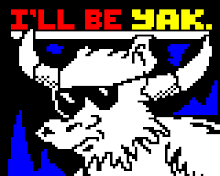 Came across this band when browsing through a book: Factory Records - the Complete Graphic Album. Their album art is worth a mention here due to its association with the pixel and the electronic age - not 100% pixellated but heavily relies upon it.
Came across this band when browsing through a book: Factory Records - the Complete Graphic Album. Their album art is worth a mention here due to its association with the pixel and the electronic age - not 100% pixellated but heavily relies upon it.Electronic's eponymous debut album (right) was released in 1991 prior to the 'Internet Boom', a time when the pixel was more associated with scientific stuff than a reminiscence of the past, as is the feeling in some quarters today. The interlacing/monitor flicker lines over the faces on the upper part would seem to back this up.
 The single cover for 'Feel Every Beat' (left) also includes some of the previously mentioned elements. This time I am not sure if the pixellated figures are representing anything but they look pretty cool, actually. Might be something to do with the light blue colour scheme conjuring images of summer skies that makes this interesting to me. Not that you ever get blue skies in the north west of England.
The single cover for 'Feel Every Beat' (left) also includes some of the previously mentioned elements. This time I am not sure if the pixellated figures are representing anything but they look pretty cool, actually. Might be something to do with the light blue colour scheme conjuring images of summer skies that makes this interesting to me. Not that you ever get blue skies in the north west of England.Also reminds me in some vague way of scientific/medical charts, in particular those displaying DNA information, such as those in this image.
Back to the band. Not strictly electronica, but maybe the whole electronica scene would have more of the same design aesthetics. Worth looking further into, maybe?
More info at Wikipedia



 Google, 11/11/98
Google, 11/11/98 


















